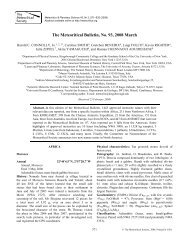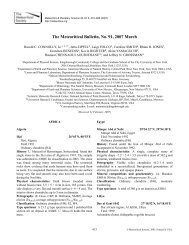Create successful ePaper yourself
Turn your PDF publications into a flip-book with our unique Google optimized e-Paper software.
564<br />
concentration of thorium (an exemplary incompatible<br />
trace element; on the <strong>Moon</strong> such elements are<br />
strongly concentrated into a potassium, REE- and<br />
phosphorus-rich component known as KREEP) is<br />
3.5 times higher on the hemisphere centered over<br />
Oceanus Procellarum compared to the hemisphere<br />
antipodal to Procellarum, although it should be<br />
noted that this conclusion is based on a correction to<br />
the initial (e.g., Lawrence et al., 1998) calibration<br />
for the Prospector thorium data (Warren, 2003).<br />
<strong>1.21</strong>.3 MARE VOLCANISM<br />
<strong>1.21</strong>.3.1 Classification of Mare Rocks<br />
<strong>The</strong> dark basalts that erupted to veneer the<br />
<strong>Moon</strong>’s flat, low-lying “seas” (maria) during<br />
the waning of lunar magmatism are compositionally<br />
distinctive, even compared to other<br />
lunar samples. Mare basalts have high<br />
(mostly .16 wt.%) FeO, low to moderate mg<br />
(¼MgO/[MgO þ FeO]), low to high TiO2, and<br />
low Al 2O 3 contents (Figure 1 and Table 2).<br />
Calling these rocks “basalt” is potentially misleading.<br />
Most mare basalts are far more melanocratic<br />
(mafic silicate-rich feldspar-poor) than<br />
terrestrial basalt, and arguably more analogous<br />
to a relatively leucocratic and low-mg komatiite.<br />
<strong>The</strong> contrast with the rest of the <strong>Moon</strong>’s crust is<br />
stark. <strong>The</strong> typical composition of highland crust,<br />
as represented by lunar-meteoritic regolith breccias<br />
and regolith averages for the Apollo 14,<br />
Apollo 16, and Luna 20 sites (Table 3), features<br />
,5 wt.% FeO, ,0.4 wt.% TiO2, and ,27 wt.%<br />
Al2O3. <strong>The</strong> distinction between mare and highland<br />
<strong>The</strong> <strong>Moon</strong><br />
materials is seldom controversial, but for quickand-dirty<br />
mare versus highland classification<br />
based exclusively on bulk-analysis data, Wood<br />
(1975) proposed using a combination of wt.%<br />
TiO2 and Ca/Al ratio (Figure 2).<br />
<strong>The</strong> various subclassifications for mare basalt we<br />
describe below may seem arbitrary but, as will be<br />
discussed in the next section, mare basalt compositional<br />
diversity is in general not systematic, but<br />
haphazard. On Earth, volcanic diversity is largely a<br />
function of systematic global tectonics, such as<br />
upwelling at mid-ocean ridges to generate MORB.<br />
But plate tectonics probably never occurred on the<br />
<strong>Moon</strong>; and it surely never occurred during the<br />
comparatively late era of mare volcanism.<br />
Mare basalts are classified primarily on the<br />
basis of their highly diverse bulk TiO2 contents.<br />
Those with ,1.5 wt.% TiO2 are termed very-low-<br />
Ti (VLT), those with 1.5 , TiO2 , 6 wt.% as<br />
medium-Ti, and those with .6 wt.% TiO2 as high-<br />
Ti. In pre-2001 literature (e.g., Neal and Taylor,<br />
1992), these same classes were called “VLT,”<br />
low-Ti, and high-Ti, respectively. <strong>The</strong> bizarre<br />
usage of “low-Ti” for basalts with up to 6 wt.%<br />
TiO2 was a historical accident: in the first studies<br />
of lunar rocks from Apollo 11, the only large<br />
igneous rocks happened to all be “high-Ti.” Le Bas<br />
(2001) has suggested calling these three groups<br />
titanium-poor, medium-Ti, and titanium-rich, but<br />
judging from more recent publications (e.g.,<br />
Hiesinger et al., 2002; Gillis et al., 2003; Jolliff<br />
et al., 2003), this terminology has not been widely<br />
adopted. To minimize confusion, I choose to<br />
adopt the Le Bas “medium-Ti” replacement for<br />
“low-Ti,” but continue using the old and logical<br />
terms VLT and high-Ti.<br />
Figure 1 Mare basalt major elements: mg versus TiO 2. Note that the apparent bimodality in TiO 2 may be<br />
misleading (see text) (data are mainly from the compilation of Haskin and Warren, 1991).





